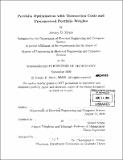Portfolio optimization with transaction costs and preconceived portfolio weights
Author(s)
Myers, Jeremy D. (Jeremy Dale)
DownloadFull printable version (4.067Mb)
Other Contributors
Massachusetts Institute of Technology. Dept. of Electrical Engineering and Computer Science.
Advisor
Leonid Kogan.
Terms of use
Metadata
Show full item recordAbstract
In the financial world, many quantitative investment managers have developed sophisticated statistical techniques to generate signals about expected returns from previous market data. However, the manner in which they apply this information to rebalancing their portfolios is often ad-hoc, trading off between rebalancing their assets into an allocation that generates the greatest expected return based on the generated signals and the incurred transaction costs that the reallocation will require. In this thesis, we develop an approximation to our investor's true value function which incorporates both return predictability and transaction costs. By optimizing our approximate value function at each time step, we will generate a portfolio strategy that closely emulates the optimal portfolio strategy, which is based on the true value function. In order to determine the optimal set of parameters for our approximate function which will generate the best overall portfolio performance, we develop a simulation-based method. Our computational implementation is verified against well-known base cases. We determine the optimal parameters for our approximate function in the single stock and bond case. In addition, we determine a confidence level on our simulation results. Our approximate function gives us useful insight into the optimal portfolio allocation in complex higher dimensional cases. Our function derivation and simulation methodology extend easily to portfolio allocation in higher dimensional cases, and we implement the modifications required to run these simulations. Simple cases are tested and more complex tests are specified for testing when appropriate dedicated computing resources are available.
Description
Thesis (M. Eng.)--Massachusetts Institute of Technology, Dept. of Electrical Engineering and Computer Science, 2009. Cataloged from PDF version of thesis. Includes bibliographical references (p. 87-88).
Date issued
2009Department
Massachusetts Institute of Technology. Department of Electrical Engineering and Computer SciencePublisher
Massachusetts Institute of Technology
Keywords
Electrical Engineering and Computer Science.